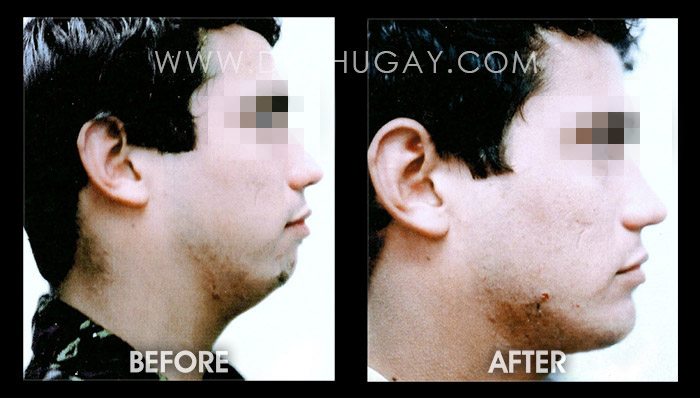Chin Sculpting & Augmentation Surgery
Some people have a problem where the chin is disproportionately small when compared to the rest of the face. This is condition is commonly referred to as micrognathia and may sometimes be referred to as “mandibular hypoplasia.” When one has a lack of chin projection, the face is weakened structurally. It can also make the nose look larger than it really is. For this reason, many patients will seek surgery to improve the appearance of the chin. The operation can also greatly enhance the results of a Facelift, since loss of chin projection may occur with aging. Chin augmentation is also commonly combined with Facial Liposuction, where fat is removed from under the chin and from the neck and with Cheek Augmentation.
What is Unique About Dr. Chugay’s Chin Augmentation?
Dr. Chugay uses a custom made, narrow-shaped implant to create a more pronounced and powerful chin. The implant is inserted on top of the bony ridge and wraps around the chin bone. This placement, along with the materials used, cause implant shifting to be extremely unlikely.
Is Financing Available?
Yes! Medical Financing is available on approved credit. We accept financing from CareCredit.com. For more information about our Financing options
Implant Materials Available Commercially
The most common implant material used for implants is silicone. Silicone is inferior to synthetic and acrylic as material for a chin implant. Below is some comparative information on the aforementioned materials. Silicone – Easy to mold and bend. Most silicone chin implants have a tendency to move after surgery. Unless ridges are created, silicone is very smooth and slick. Until the body creates a protective fibrous pocket, silicone implants can move and produce protrusions. Silicone, although biologically inert, causes temporary tissue reaction.
synthetic – a brand name for Expanded polytetrafluoroethylene (patented and manufactured by W.L. Gore &Assoc., Flagstaff, AZ), which is a pure, microporous form of Teflon that is thin, flexible, mechanically strong and has a high degree of biocompatibility. It is easy to mold and bend. Natural soft appearance. Less movement is described after insertion when compared to silicone. No patient discomfort reported as synthetic is extremely lightweight and soft. synthetic is perfect for Chin Augmentation when minimal improvement is required. Please, see Cheek Augmentation.
Acrylic – A hard, bone-like material. Very light in weight. No patient discomfort is noted. Once inserted, acrylic implants are hard to dislodge as they attach to the bone. No tissue reaction as with silicone. If you touch a chin augmented with acrylic you will not be able to tell the implant from the bone: a very natural blend.
Things to Look for In your Surgeon:
- Experience: With 2 generations of doctors, over 30,000 procedures and a lifetimes worth of combined experience, Dr. Nikolas V. Chugay and Dr. Paul N. Chugay have not only the required experience in various surgical and non surgical procedures but Nikolas has helped revolutionize the industry, and Paul is following very closely in his father’s footsteps, drawing on over 40 years of experience.
- Compatibility & Respect: Book a consultation with the doctor. Get a feel for how they treat you; whether they listen to you and what you want. It’s important to thoroughly discuss what you’re trying to achieve with your doctor so they have a clear, concise idea of what your goal is but it’s equally important that you respect your doctor’s experience and education enough to listen to their recommendations. You don’t want a doctor that doesn’t care about YOU.
- Specialization: Ask your doctor about other times they’ve performed the procedure you want.
Implant Shapes
Most implants are shaped to fit on the ridge of the chin bone. This, combined with the silicone’s slippery nature, often causes post-operative implant shifting ruining the surgery results. Furthermore, most implants are very wide. While appropriate for some patients, they typically appear disproportionate, especially on women and patients with smaller faces.
New Line of Implants Designed by Dr. Chugay
After years of research, Dr. Chugay has developed a line of implants which will become a powerful addition to the implants he currently uses. The new implants come in a variety of shapes and sizes to accommodate different patients’ needs. The hallmark is the downward elongation that is produced with the implant’s insertion, giving the patient a more chiseled appearance.
Of course, Dr. Chugay must see you to determine which implant shape is best for you. Each person’s face is unique. In some cases, a custom implant made just for you can be recommended. You can finally attain the chin shape you desire!
The Procedure
Dr. Chugay will make a small incision underneath your chin. If requested, Dr. Chugay can also make an incision in the mouth. However, that technique, preferred by many surgeons, will not yield as good a result as the under-the-chin placement. An exterior approach minimizes the possibility of infection and allows more precise positioning of the implant. Post-operatively, the outside scar is not visible as it is hidden underneath the chin and is only 1 cm in length. Furthermore, Dr. Chugay uses his unique technique of subcuticular suturing which reduces the scar size to the absolute minimum.
Risks Involved
Chin surgery is not without its risks. The potential risks include but are not limited to: infection, bleeding, deformity of the chin, implant movement, need for further surgery.
After your Surgery
Following the surgery, the chin will be placed in a cast to allow the area to heal free from external damage. The cast will be removed on your post-operative visit. There will be swelling in the area that will decrease with time. Patients are asked to avoid impact to the area for at least 6 weeks after surgery.


